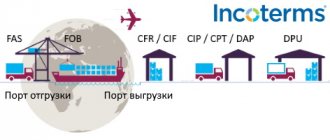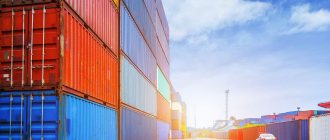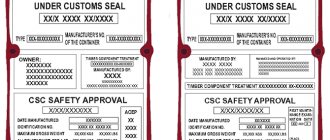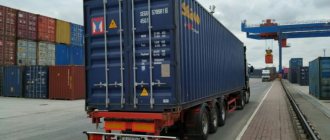Container transportation is a modern popular type of delivery of goods and personal belongings over long distances with a guarantee of maintaining their quantity and appearance. After equipping the FCT (the first container terminal) with satellite systems for cargo tracking, a convenient option became available - obtaining information on the container. This service, available thanks to a worldwide unified system for drawing up accompanying documents and classifying containers, is also provided by KTSP and PLP terminals.
Information on the PKT container
The first container terminal is the place where such a service is most relevant, since this is where the majority of ships arriving from the largest ports in Europe are unloaded. To obtain a certificate, just go to the website of PKT or the Rolis logistics system and enter the container number, this allows you to:
- find out about the arrival of the container;
- for goods that require the creation of certain temperature conditions, obtain an expanded overview of information about the conditions of its storage.
WHAT CAN INTERFERE
Sometimes the inability to obtain cargo information may be caused by a system failure. If the problem is not resolved within a few hours, it is recommended to contact the terminal staff, who will promptly inform you about all the nuances, or directly to the sender of the module.
Reasons that may prevent you from obtaining a certificate:
- incorrect indication of departure date;
- repetition of documents when forwarding;
- incorrect data about the recipient/sender;
- sending several containers using one document;
- absence of a title page or its incorrect design.
All documentation must be drawn up in full compliance with the requirements, otherwise the resulting confusion will seriously complicate not only obtaining reference information, but also the process of container delivery itself. It is recommended to be careful when filling out papers and electronic forms.
What factors may interfere with obtaining a certificate?
Violation of the requirements for drawing up accompanying documentation leads to confusion in recognizing a specific cargo module, which complicates not only obtaining a certificate, but also the fact of delivery to the recipient. What violations occur when creating a package of documents:
- absence or incorrect design of the title page;
- inaccurate information about the shipper, consignee, date;
- sending several cargo modules using the same documents.
The cause of confusion may be duplication of documents when re-sending cargo from the same sender.
The convenience of container transportation has already been appreciated by many entrepreneurs who use it to deliver goods from any country with a guarantee of its safety. However, you always want to keep your finger on the pulse and know exactly when to expect the arrival of cargo in order to prepare everything for its acceptance and placement. This is precisely why the Rolis logistics information system provides information on the container (PKT and other large terminals can be checked in this way). Container information helps determine where the container is currently located, for example, whether it has already arrived from Finland to St. Petersburg (in the case of the terminals listed above). To do this, you just need to indicate its number. Among the opportunities offered by Rolis are information about the container on an ongoing basis or a one-time receipt of the information you are interested in.
The first container terminal (FCT) is the place where container information is most often needed. Every day, a huge number of ships arriving from the largest ports in Europe are unloaded on its territory, so it is very important to keep proper records of all container packaging. However, it is important for consignees to receive information from other Russian terminals in a timely manner.
Reasons for refusal to issue documents
You may be refused to provide information if for some reason a failure occurs within the system. There may be several reasons for this:
- Incorrect information was provided about all parties working with the cargo - recipients, sender, owner.
- There is no title page or there are serious factual errors in the accompanying documentation.
- The shipping date is incorrect.
- Several cargo blocks are sent at once with one document issued for them.
Sometimes a program malfunction may be temporary - then you need to wait until the situation is corrected. If the problem persists, contact the sender or the terminal directly for clarification.
Operational information on containers at PLP and CTSP
KTSP is a terminal, which, like PKT, is located on the territory of the Bolshoi port in the city of St. Petersburg. Its capacity is not so great, however, it also regularly receives ships with a large number of containers. Therefore, information on a container at the KTSP terminal is also a very popular service.
Also in this port, stevedoring operates, which has its own terminal that accepts cargo containers. Vessels with European imports arrive here from the Baltic and North Sea. Therefore, a PLP container certificate is needed for entrepreneurs doing business with partners from the EU. For Petrolesport, container information is not provided using the Rolis system, but it can also be obtained on the company’s website.
Temporary storage warehouse of JSC First Container Terminal (JSC PKT)
| Name of temporary storage warehouse | Joint Stock Company "First Container Terminal" JSC "PKT" |
| Address | 198035, St. Petersburg, Mezhevoy Canal, 5; 3rd district |
| Warehouse area | 89 ha |
| Certificate number | 10216000/150720/00011/2 from 07/15/2020 |
| Types of transport served | road, sea, railway |
| Owner's TIN | 7805113497 |
| Owner's checkpoint | 780501001 |
| OGRN of the owner | 1027802712343 |
| Customs post code | 10216100 |
| The name is there. organ | Customs post Turukhtanny of the Baltic customs of the Federal Customs Service of the Russian Federation |
| Customs office address | 198035, St. Petersburg, 3rd district of the Seaport, lit. P |
Smooth work with containers - from purchase to certificate of their location
If you decide to send your cargo in containers, you have made the right choice - this delivery method is considered one of the safest. It is only important to purchase high-quality containers that will not let you down and will be resistant to all kinds of external factors, which are inevitable on the road.
You can buy reliable containers made of durable metal at. The company sells containers of various sizes at an affordable price. By ordering a container from Logikont, you can be sure that it will withstand even a long sea voyage. And you can track its location using any service convenient for you, depending on which port and terminal the cargo is expected to arrive at.
The Port of St. Petersburg is one of the main cargo ports in the North-West and has an extensive structure. On the territory of the port there are several dozen terminals belonging to different owners, such as CJSC First Container Terminal (PKT), OJSC Petrolesport (PLP) and others.
A schematic map of the port of St. Petersburg will help you get an idea of the location of such port areas as cargo, PKT, Novy Port railway station and PLP.
Customs broker services at the temporary storage warehouse of JSC "PKT"
Our company “Universal Cargo Solutions” provides services as a customs representative - customs broker at the temporary storage warehouse of JSC PKT in the seaport of St. Petersburg. Our declarants carry out professional customs clearance of containers, cargo of any hazard class, as well as oversized and heavy cargo. We carry out customs clearance of goods in all customs regimes and procedures: release for domestic consumption (import), export, customs transit and others.
We work with all participants in foreign economic activity (FEA):
- Individuals
- Legal entities
- Individual entrepreneurs
Documents and information for customs clearance at the temporary storage warehouse of JSC First Container Terminal
- List of documents for registration of an individual at customs (View)
- List of documents for registration of a Legal entity at customs (View)
- List of documents for registration of an individual entrepreneur at customs (View)
- List of documents for customs clearance “Import” (View)
- List of documents for customs clearance “Export” (View)
- Sample payment order to ELS customs (View)
- Temporary storage warehouse license First Container Terminal (View)
First container terminal
CJSC First Container Terminal (PKT) is a system for carrying out various operations at the port and has now become one of the largest terminals handling heavy weight containers. It occupies an absolute leading position on the Baltic Sea. Possessing freeship connections, the First Container Terminal has constant connections with large ports in European ports, including Rotterdam, Hamburg, Bremerhaven, Antwerp. Recently, the St. Petersburg first container terminal was equipped with a refrigeration system, which is one of the largest in Europe. All operations in the system are carried out using the latest technologies: IT, satellite monitoring of cargo containers, electronic document management.
Terminal equipment
Currently, the First Container Terminal (FCT) is equipped with the most modern types of equipment. The bulk of it consists of cranes with different lifting capacities, which allows you to work with loads of a wide variety of weights, including oversized ones. On average, the weight of cargo can be up to 50-100 tons. The terminal also has its own developed infrastructure and a large number of container loaders. Its refrigerated section ranks third among European countries and fifth in the world in terms of its equipment.
Price
One consignment of goods is understood as a consignment of goods sent at a time to the consignee using one waybill in one vehicle within the framework of one foreign trade contract.
The cost is determined individually for each delivery, since the composition of terminal processing services may vary greatly from batch to batch.
| Type of work | Cost without VAT) |
| Carrying out customs operations and customs declaration of goods of one consignment in import mode (IM 40): - consulting on customs clearance issues; — checking the package of documents provided by the Customer for customs clearance of one consignment (including shipping documents); — formalization of delivery documents, preparation, filling out the declaration form and electronic submission to the customs authority. | from 5,000 rubles |
| Carrying out customs operations and customs declaration, in relation to each subsequent consignment in import mode, if there are several consignments in one vehicle (IM 40): - consulting; — checking the package of documents provided by the Customer for customs clearance of one consignment (including shipping documents); — formalization of delivery documents, preparation, filling out the declaration form and electronic submission to the customs authority. | from 4,000 rubles |
| Registration of each additional sheet of goods declaration, starting from the 5th (fifth) product in the import mode (IM 40). | from 450 rubles |
| Carrying out customs operations and customs declaration of goods of one consignment in export mode (EC 10): - consulting on customs clearance issues; — checking the package of documents provided by the Customer for customs clearance of one consignment (including shipping documents); — formalization of delivery documents, preparation, filling out the declaration form and electronic submission to the customs authority. | from 3,000 rubles |
| Carrying out customs operations and customs declaration of goods of one consignment (other modes): - consulting; — checking the package of documents provided by the Customer for customs clearance of one consignment (including shipping documents); — formalization of delivery documents, preparation, filling out the declaration form and electronic submission to the customs authority. | from 10,000 rubles |
| Payment (additional payment) of any types of customs duties under one DT on behalf and on behalf of the Customer, using the representative’s own funds through terminal payment using a customs card/online service of the ROUND payment system. | from 3% of the documented payment amount (additional payment), but not less than 1,000 rubles |
| Assistance in obtaining a Declaration of Conformity with the CU TR for goods, as well as other permitting documents. | discussed individually |
Additional services
The main task of the PKT is to carry out loading and unloading operations. As well as temporary storage of containers with cargo on the territory of the terminal. In addition, a large number of additional services are provided here, including steaming and trimming containers, and various movements around the terminal. The terminal actively cooperates with the Federal Customs Service and provides customs clearance services, thanks to which you can quickly and without unnecessary problems transport goods abroad.
How to obtain information about the location of a container
- home
- About the company Documents
- Guarantees
- our clients
- Question answer
- Dry cargo sea containers 10ft containers
- 40'DC standard
- Container dimensions 10 feet
- 3 ton containers
- 10 foot
- Price list
- Spare parts for refrigerated containers Spare parts for Carrier
- Bulk Container
- Rental of dry cargo containers
- Carrier Repair
- 40ft container with additional side door
- Storage of containers with connection
- Price list for dry cargo containers
Prospects for the development of PCT
According to the management of the First Container Terminal, expansion of the terminal area is planned in the near future. And also the rationalization of its use through the installation of multi-tiered storage areas for containers with cargo. It is also very important to constantly purchase new models of loading equipment.
In container shipping, it is important to understand the current location of the cargo. This allows you to understand whether there is a possible delay in transit and whether the container is moving on schedule. To ensure information content, a system for issuing certificates about the location of the block was created.
Modern satellite systems are used in our work. The complex allows you to get answers to two main questions:
- Where is the cargo block?
The information helps to track how cargo is moving and to know earlier that the container has arrived at the port. This is important to ensure compliance with the originally stated transportation deadlines. - Under what conditions is the cargo stored?
If you work with perishable products or cargo that requires a special environment, a container certificate will help identify violations at an early stage. This is a chance to avoid many problems and potential costs.
What information does the certificate contain?
The certificate will contain information about the current location and storage conditions of your cargo. The document is issued upon request, certified by the official seal and signature of the responsible person.
Forwarding occurs according to the group code assigned to the cargo - it is read at the container terminal. The code reflects:
- Container type. It can be either standard or refrigerated, equipped with additional means for complex sealing.
- Owner code. This code will determine whether the document can be provided to you.
- Equipment category identifier. It indicates what additional accessories the unit is equipped with. An example is a refrigerator.
A unique six-digit serial number and control number are also written down.
Having received a certificate confirming your presence in a certain terminal, time of arrival and storage, you can understand whether the required conditions are met and whether there is a potential risk of damage.
Information on containers at the terminals of the ports of St. Petersburg PKT, PLP, KTSP, MRP
In order to obtain a certificate for a container in the port terminals of St. Petersburg, you need to go to the official website of the responsible company. The addresses are as follows:
- Help on the PKT container (First Container Terminal)
: https://www.fct.ru/operinfo/ContainerInfo.php. - Documents from PLP (JSC Petrolesport)
: https://www.rlisystems.ru/info/operinfo/ContainerInfo/ContainerInfoPLP.php. - Certificates from the Sea Fishing Port (MSRP)
: through the “Personal Account” at the link https://www.seafishport.ru/clients/spravka-po-kontejneru/. - Information from the St. Petersburg Container Terminal (CTSP)
: https://www.terminalspb.ru/.








